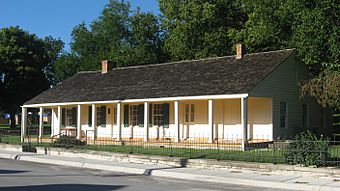Creole House facts for kids
Quick facts for kids |
|
|
Creole House
|
|
|
U.S. Historic district
Contributing property |
|

Front and southern (older) end of the house
|
|
| Location | Market St., Prairie du Rocher, Illinois |
|---|---|
| Area | 1.7 acres (0.69 ha) |
| Built | 1800 |
| Architectural style | Poteaux-sur-sol |
| Part of | French Colonial Historic District (ID74000772) |
| NRHP reference No. | 73000717 |
| Added to NRHP | April 3, 1973 |
The Creole House is a very old home in the village of Prairie du Rocher, Illinois. This area was once a French settlement in the United States. The house was built around 1800 and later made bigger.
It is the last house of its kind left in Illinois. This makes it a special example of vernacular architecture, which means a building style that uses local materials and traditions. The Creole House helps us understand the history of French settlers in the Upper Mississippi Valley.
History of the Creole House
French settlers started the village of Prairie du Rocher around 1722. Many houses from the 1700s still stand there today. The Creole House was built around 1800. An English-speaking immigrant from the eastern United States built it in the French Colonial style. This builder was one of the first American settlers in Illinois. In 1800, only about 800 Americans lived in what is now Illinois.
From 1830 to 1848, a local miller named William Henry owned the house. Later, his son-in-law, A.H. Lee, took ownership. In 1855, F.W. Brickey bought the house. He moved in around 1855 and three years later, he made the house twice as big! Brickey's family owned the house for many years.
A famous person who lived in the Creole House was Henry Clay Hansbrough. He was the son of E.C. Hansbrough, who lived there starting in 1845. Henry Clay Hansbrough grew up to be an important Republican politician. He became a U.S. senator for North Dakota. A U.S. Senator is a person elected to represent their state in the United States government.
How the House Was Built
Even though Americans built it, the Creole House looks like a French colonial style called poteaux-sur-sol. This building method is not found anywhere else in Illinois today.
Imagine building a fence with logs standing straight up. That's similar to how these houses were made! They put a row of logs upright on a stone foundation. This is different from modern houses that use horizontal beams or studs.
The roof is held up by strong oak beams called rafters. The original roof is gone, and now it has modern composite shingles. Inside, the floors are made of pine boards, and the walls are covered in plaster. There are several fireplaces in the rooms, with wooden mantels around them.
The original part of the house is the southern half. The northern half was added in the 1850s. This newer part was built using the more modern stud-based method. Even though they were built differently, the two parts look similar from the outside. This is because both halves were covered with clapboard siding when the northern part was built.
The roof extends far past the front of the house, creating a long porch. The yard around the house has some trees and is surrounded by a cast iron fence.
Keeping the House Safe
In 1973, the Creole House was added to the National Register of Historic Places. This list helps protect important historical sites. The house was chosen because of its unique colonial architecture. It is the only original house of its kind left in Illinois.
At that time, no one lived in the house. The Randolph County Historical Society owned it and was working to restore it. A year later, much of Prairie du Rocher became a historic district called the French Colonial Historic District. This district also included other important places like the remains of old Kaskaskia and the site of Fort de Chartres. It also included archaeological sites, which are places where people find old objects to learn about the past.
The Creole House was seen as a very important part of this historic district. By creating the district, officials wanted to show how important places like the Creole House are. They help us remember the strong French influence on the region. The historical society still uses the house today and holds historical events there.



